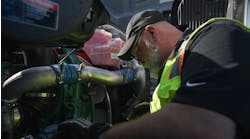There has been continuing research into the genetics of maintenance workers. Significant research, funded by major corporations, has continued to crack the genetic code to an even more granular level.
Companies invest in this type of research because they would love to clone their best maintenance workers. Just as importantly, companies would like to make fewer mistakes in the maintenance worker selection process. Imagine the competitive advantage of being able to identify great maintenance folks at birth.
In my original article on maintenance genetics, Maintenance Worker Genetics, published in Fleet Maintenance in 2004 when maintenance genetics was in its infancy, five genetic traits were identified:
- Pissing and Moaning Gene – Maintenance personnel are never satisfied.
- Packrat Gene – Maintenance personnel can’t throw things away.
- Tool Gene – Maintenance personnel spend an inordinate amount of time with tool truck people.
- Independence Gene – Getting maintenance personnel to go in the same direction is like herding cats, it’s a difficult task.
- Dirt Gene – Maintenance personnel seem to attract dirt to their person, even right after arriving at work.
Extensions to Known Genes
Further investigation has identified some variations and additional traits in the initial genes, plus some overlooked genes from the original research.
It is important to note that not all maintenance folks have all the identified genes.
The recently discovered additions to the maintenance worker genes are:
Extensions to the Dirt Gene – A new aspect to the Dirt Gene is the inability to see the dirt they create doing a maintenance job, and thus they don’t clean it up. Naturally, if someone can’t see the dirt, they can’t be expected to clean it up.
The researchers found that some teenagers temporarily share this gene, but it reverts to a healthy form when they become adults, so clearly more research is needed.
Extensions to the Independence Gene – In addition to it being hard to get maintenance folks to align and pull in a given direction, the research shows there are some other related traits. These include being hard headed and always thinking that they are right, even if it is clear they are wrong. This hardheadedness serves them well 95 percent of the time when they are right. The other 5 percent of the time is usually painful for their organization.
New Genes
The most recent research into maintenance worker genetics has detected these new genes:
Barrier Fixation – This is the trait of spending most of their time in meetings fixated on things outside their control. It might be vendors or suppliers, or it might be inside departments such as purchasing, accounting, finance, etc. No matter what is brought up in a meeting, this gene will force the person to come back to this barrier.
Monosyllabic Gene – Ask any maintenance person a question, particularly when they are doing something or possibly ignoring you, and they will answer in as few syllables as possible. While maintenance folks are people of few words when questioned or in meetings, they are veritable gushers of information when you say the magic word or phrase. For example, if you happen to muse about the head bolting pattern on a 1967 Chevrolet Corvette, you might never get to go home. The problem is, it is almost impossible to know the magic word or phrase.
The bottom line to maintenance worker genetics is this: Regardless of what genes maintenance folks have, it is necessary to show mercy and compassion to them. The health of your equipment may depend on it.
Joel Levitt is director of projects for Reliabilityweb.com’s Reliability Leadership Institute. Reliabilityweb.com provides the latest reliability and uptime maintenance news and educational information to help make asset managers, reliability leaders and maintenance professionals safer and more successful. The Reliability Leadership Institute is a community of practice to improve how organizations deliver asset performance through the use of Uptime Elements, a reliability framework
Editor’s Note: The research into the genetics of maintenance workers is tongue-in-cheek and is not to be taken seriously.




